Implied texture powerpoint
- 2. Texture that can be seen, but not felt http://www.123rf.com/photo_465859_grid-texture-in-black-and-white.html
- 3. *THE HATCHING TECHNIQUE originated in the MIDDLE AGES *Hatching is an artistic tecnhnique used to create shading effects by drawing closely spaced parallel lines *Hatching is important in liner media like DRAWING and PRINTMAKING TYPES OF PRINTMAKING… -LINO CUTS -ENGRAVINGS -ETCHINGS -WOODCUTS http://drawsketch.about.com/library/blinkt exture.htm
- 4. *THE CROSSHATCHING TECHNIQUE became popular in WESTERN ART *Artists use this technique, varying the length, angle, closeness and other qualities of the lines *This technique was started to take HATCHING Further on the textured value scale *Crosshatching is often seen in drawings, linear paintings, engravings and woodcuts http://www.bigtimeattic.com/blog/2007/06 /cartooning-tips-and-tricks.html
- 5. *STIPPLING is the creation of a pattern simulating varying degrees of solidity or shading by using small dots. *POINTILLISM is a style of painting founded by artists Georges Seraut and Paul Signac in 1886 as a branch of IMPRESSIONSIM. *POINTILLISM is much like STIPPLING in that the artwork is made up of thousands of colored dots of color. Up close they don’t look like much at all. From a distance they begin to take shape. http://www.artyfactory.com/pen_and_ink_d rawing/pen_and_ink_drawing_7.htm
- 6. *With this technique, you simply come up with a pattern you like and repeat it. *The closer the lines get together in the pattern, the darker the area of the object will appear. http://www.etsy.com/listing/90924410/illust ration-elephant-and-bird-art?ref=market
- 7. *Using the rectangular stencil provided, trace out 5 rectangles 2” x 12” *We will divide each rectangle into 6 equal 2” x 2” squares *We will be creating our IMPLIED TEXTURE SCALES as seen to the side. *The farther the lines are apart from each other, the lighter the surface appears to be. *The closer the lines get together, the darker the surface appears to be. http://fc04.deviantart.net/fs42/f/2009/090/ b/d/Value_Scales_by_Neiya.jpg
- 8. *Using the rectangular stencil provided, trace out 5 rectangles 2” x 12” *We will divide each rectangle into 6 equal 2” x 2” squares *We will be creating our IMPLIED TEXTURE SCALES as seen to the side. *The farther the lines are apart from each other, the lighter the surface appears to be. *The closer the lines get together, the darker the surface appears to be.
- 10. GUIDELINES: *Finish IMPLIED TEXTURE VALUE SCALES *Decide what type of artwork you want to create for this project… Realistic Landscape Surrealistic Landscape Realistic Portrait Surrealistic Portrait Realistic Animal Surrealistic Animal Realistic Observational Study Surrealistic Observational Study *All Projects will be sketched out first in pencil and finished with PEN and INK *** IMPORTANT*** *Take your time when drawing in your implied textures. *Make each line purposeful. * This project is all about line quality.
- 12. I N N AT U R E http://blogs.egusd.net/azevedo/2013/09/28/ elements-of-art/
- 13. I N N AT U R E http://4.bp.blogspot.com/_6R396cV4IYE/SjacxcfuwJI/AAAAAAAAAPQ/wncr we34d3M/s1600-h/Pen_Ink_Texture_Thumbs.jpg
- 14. I N N AT U R E http://tamutimes.tamu.edu/2013/03/13/bad-news-again-for-monarchbutterflies/#.UnWEURZCcts
- 15. I N A RT WO R K http://keithmallett.com/cats_in_hats_ http://sixstoriesup.com/2011/12/ etchings
- 16. THE RUBRIC
- 17. IMAGES CITED: -Art Factory. (n.d.). Stippling Examples, [graphic image]. Retrieved from http://www.artyfactory.com/pen_and_ink_drawing/pen_and_ink_drawing _7.htm -Blogspot. (n.d.). Pen and Ink Texture, [illustration]. Retrieved from http://4.bp.blogspot.com/_6R396cV4IYE/SjacxcfuwJI/AAAAAAAAAPQ/wncrwe34d 3M/s1600-h/Pen_Ink_Texture_Thumbs.jpg -Cannon, Kevin. (June 29, 2007). Cartooning Tips and Tricks: Crosshatching, [drawing]. Retrieved from http://www.bigtimeattic.com/blog/2007/06/cartooningtips-and-tricks.html -Durer, Albrecht. (n.d) Classic Durer Engraving, [illustration]. Retrieved from http://www-cs.engr.ccny.cuny.edu/~wolberg/projects/engraving/ -Frey Photography. (n.d.) Texture, [photography]. Retrieved from http://blogs.egusd.net/azevedo/2013/09/28/elements-of-art/
- 18. IMAGES CITED: -Oschmann, Suzan. (n.d) Stock Photo – Grid Texture in Black and White, [photograph]. Retrieved from http://www.123rf.com/photo_465859_gridtexture-in-black-and-white.html -South, Helen. (n.d). Pen and Ink Hatching, Crosshatching and Scumbling: Basic Pen Strokes for Ink Drawing, [illustration]. Retrieved from http://drawsketch.about.com/library/blinktexture.htm -Mallett, Keith. (n.d.). Close up detail of etching “Straight Ahead”, [illustration]. Retrieved from http://keithmallett.com/cats_in_hats_etchings -Neiya. (2009-1013). Value Scales, [illustration]. Retrieved from http://neiya.deviantart.com/art/Value-Scales-117705744 -Nelson, Dan. “Pen and Ink Cross Hatching Masters Edition.” YouTube. Mar 17, 2013. Web. Nov 1, 2013. Retrieved from http://www.youtube.com/watch?v=AHoqh27vQRw
- 19. IMAGES CITED: -NikTheArtGuy. (Dec 21, 2011). Get to the Point Already, [illustration]. Retrieved from http://sixstoriesup.com/2011/12/ -Randall, Keith. (Mar 13, 2013). Shutterstock, [photograph]. Retrieved from http://tamutimes.tamu.edu/2013/03/13/bad-news-again-for-monarchbutterflies/#.UnWEURZCcts -Vogel Lozinak, Mary. (n.d.). Elephant and Bird, [illustration]. Retrieved from http://www.etsy.com/listing/90924410/illustration-elephant-and-birdart?ref=market
- 20. IMAGES CITED: "Stippling." Wikipedia, The Free Encyclopedia. Wikimedia Foundation, Inc. 22 July 2004. Web. 1 Nov. 2013. "Pointillism." Wikipedia, The Free Encyclopedia. Wikimedia Foundation, Inc. 22 July 2004. Web. 1 Nov. 2013. "Hatching." Wikipedia, The Free Encyclopedia. Wikimedia Foundation, Inc. 22 July 2004. Web. 1 Nov. 2013. "Cross Hatching." Wikipedia, The Free Encyclopedia. Wikimedia Foundation, Inc. 22 July 2004. Web. 1 Nov. 2013.

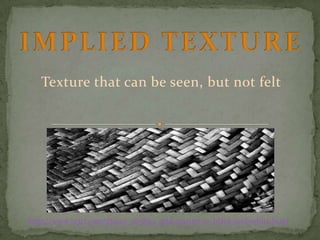




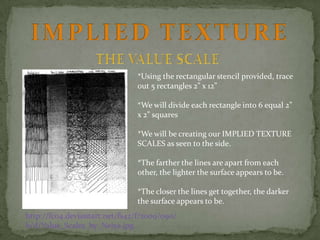
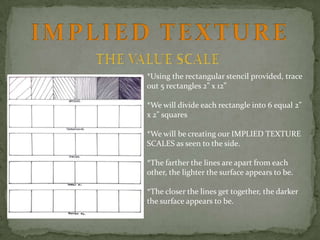

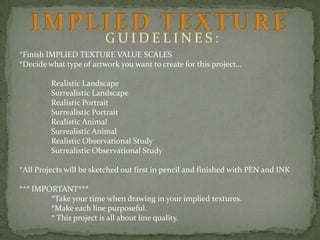


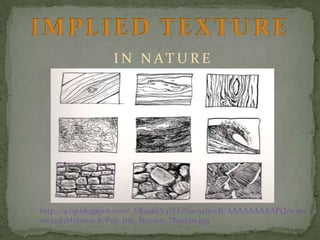


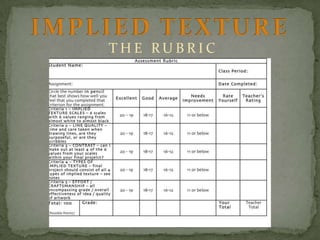
![IMAGES CITED:
-Art Factory. (n.d.). Stippling Examples, [graphic image]. Retrieved from
http://www.artyfactory.com/pen_and_ink_drawing/pen_and_ink_drawing
_7.htm
-Blogspot. (n.d.). Pen and Ink Texture, [illustration]. Retrieved from
http://4.bp.blogspot.com/_6R396cV4IYE/SjacxcfuwJI/AAAAAAAAAPQ/wncrwe34d
3M/s1600-h/Pen_Ink_Texture_Thumbs.jpg
-Cannon, Kevin. (June 29, 2007). Cartooning Tips and Tricks: Crosshatching,
[drawing]. Retrieved from http://www.bigtimeattic.com/blog/2007/06/cartooningtips-and-tricks.html
-Durer, Albrecht. (n.d) Classic Durer Engraving, [illustration]. Retrieved from
http://www-cs.engr.ccny.cuny.edu/~wolberg/projects/engraving/
-Frey Photography. (n.d.) Texture, [photography]. Retrieved from
http://blogs.egusd.net/azevedo/2013/09/28/elements-of-art/](https://image.slidesharecdn.com/impliedtexturepowerpoint-131104083925-phpapp01/85/Implied-texture-powerpoint-17-320.jpg)
![IMAGES CITED:
-Oschmann, Suzan. (n.d) Stock Photo – Grid Texture in Black and White,
[photograph]. Retrieved from
http://www.123rf.com/photo_465859_gridtexture-in-black-and-white.html
-South, Helen. (n.d). Pen and Ink Hatching, Crosshatching and Scumbling: Basic Pen
Strokes for Ink Drawing,
[illustration]. Retrieved from
http://drawsketch.about.com/library/blinktexture.htm
-Mallett, Keith. (n.d.). Close up detail of etching “Straight Ahead”, [illustration].
Retrieved from
http://keithmallett.com/cats_in_hats_etchings
-Neiya. (2009-1013). Value Scales, [illustration]. Retrieved from
http://neiya.deviantart.com/art/Value-Scales-117705744
-Nelson, Dan. “Pen and Ink Cross Hatching Masters Edition.” YouTube. Mar 17, 2013.
Web. Nov 1, 2013. Retrieved from http://www.youtube.com/watch?v=AHoqh27vQRw](https://image.slidesharecdn.com/impliedtexturepowerpoint-131104083925-phpapp01/85/Implied-texture-powerpoint-18-320.jpg)
![IMAGES CITED:
-NikTheArtGuy. (Dec 21, 2011). Get to the Point Already, [illustration]. Retrieved
from http://sixstoriesup.com/2011/12/
-Randall, Keith. (Mar 13, 2013). Shutterstock, [photograph]. Retrieved from
http://tamutimes.tamu.edu/2013/03/13/bad-news-again-for-monarchbutterflies/#.UnWEURZCcts
-Vogel Lozinak, Mary. (n.d.). Elephant and Bird, [illustration]. Retrieved from
http://www.etsy.com/listing/90924410/illustration-elephant-and-birdart?ref=market](https://image.slidesharecdn.com/impliedtexturepowerpoint-131104083925-phpapp01/85/Implied-texture-powerpoint-19-320.jpg)
